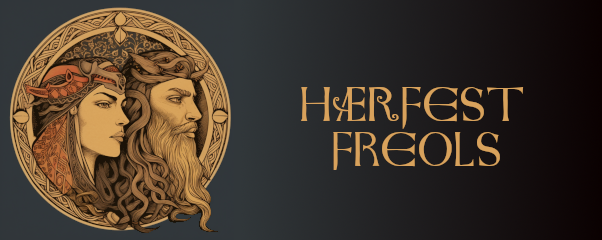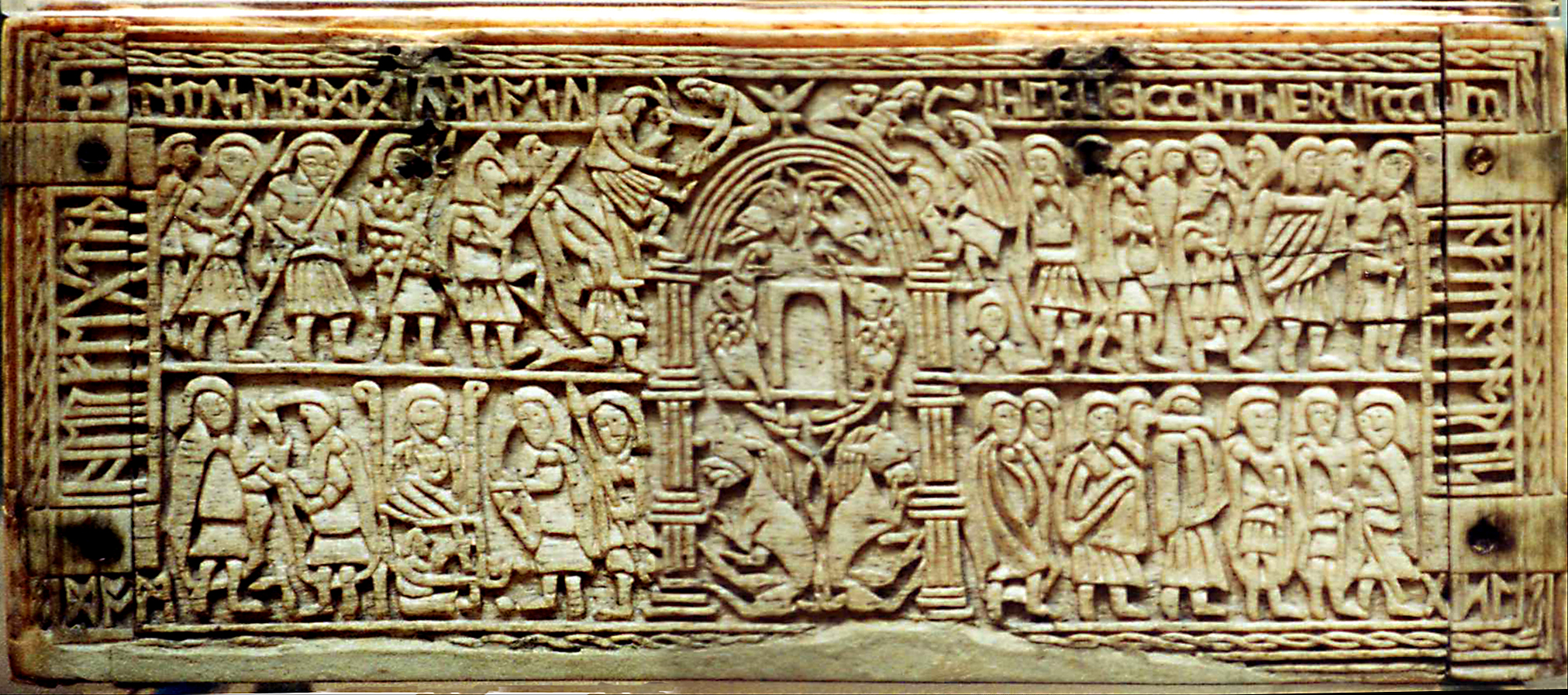Introduction
The event called blót is one of the most common, and important devotional rites of organized Heathen practice. The sacrifice could (and can still) be a very simple one, but on high feast days would typically involve feasting and speeches. Our approach here, is to view blót broadly as “a ritual sacrifice”, and provide a ritual template that can scale from a very simple offering such as a libation, to an elaborate holiday ritual that builds upon the basics. For this purpose, we divide the blót into 3 sub-rituals, wherein only the first is really required, and the additional steps can be added where appropriate.
The word blót may (or may not) be closely related to the Old English word (blod, ‘blood’) and this is a matter of some debate among linguists. Certainly, blod is related to the word bletsung, meaning ‘to bless’. Historically, blót very often did involve an animal sacrifice, meaning a beast was ritually and humanely slaughtered and exsanguinated. The meat would then be prepared for a great feast, and the blood used to bless the celebrants, probably by sprinkling the blood on the assembled worshipers, and then upon the altar as a sign of the reciprocal gifts being exchanged between gods and humans. I say “very often”, because in point of fact, non living sacrifices such as libations, or sacrifices of grain are quite historical also, and documented in the lore.
The religious celebrations of old would almost certainly have flowed naturally from a ritual sacrifice to a solemn banquet (húsel), to a community meeting (symbel), simply due to the logistics if nothing else. If a meat animal was to be sacrificed, it must be slain, prepared, and the meat cooked and eaten by the celebrants, with some being left aside for the gods before the sacrifice would have been truly complete. Thus the sacrifice flows into a communal feast, and when the food has been cleared away, a drinking banquet. Hence this template follows that same basic flow, as is fairly common in other modern branches of Heathenship. It assumes that an offering might be made without a full húsel or symbel, but it is hard to imagine the reverse. A meal is not a húsel Unless a sacrifice has been made. This template also assumes that the most rudimentary offering likely to be made by modern heathens is not one of blood, but of a sacral beverage. Hence, our most basic form of blót , the offering of. wíntíber, is assumed to be a sacrifice of mead, wine, or even beer, rather than a ritual slaughter of an animal. It should be noted that today, there are relatively few Heathens with the needed skills, opportunity and desire to perform a humane animal sacrifice, and it should NOT be attempted by those who lack any or all of the above. This author being among those who do not possess such skills, this ritual template should be understood to be designed around the offering of non-living sacrifices, principally cooked food and drink. Thus the timing and pacing may not be optimal for use in a traditional blót involving a slaughter, thought one certainly could by replacing the wíntíber as the basic rite, with an offering of a cwiclác, a living sacrifice.
Symbel may be held separately, and so a separate template does exist for that rite, but for our purpose here, let us assume that húsel and blót are considered to be linked when food is being sacrificed.
Roles
For the purposes of creating a template, the active roles have been divided up as though there was a primary organizer of the ritual, and one or more helpers. This may in actuality be a single person. Again, discretion will need to exercised in deciding how best to divide up these roles in your situation.
Blotere (Sacrificer) The principal priest for this occasion, possibly the host or the maintainer of the altar, or the Ealdor-sacerd in an organized group.
Wéofodþégn or Húselþegn (Altar Thegn) – A participant with speaking role, possibly an ordained Sacerd, head of household, or simply a celebrant with a strong interest in active participation in this rite.
Wíntíber (The Libations)
Wíntíber is an Old English term that literally means ‘wine-sacrifice’. This is a libation, a gift of strong drink to a revered being, god or gods, as a simple form of sacrifice. Ritual beverage is poured into a drinking vessel, and each draught or scenc, is passed among the celebrants so that they may offer (bedrædenna ‘prayers’) or (ellenspræca ‘powerful speech’) to the god or wight being honored (typically one per round of drink) and then consume a swallow themselves in communion with that wight or god before passing the vessel along. It is appropriate for the speech or prayer of the ritual leader to be the most elaborate, other celebrants may keep their praise and prayers simple if desired. When each round is concluded, a libation from the vessel is poured into the (húsel-fæt ‘ritual bowl’) and if desired, another round is poured, and the process repeats. When the rounds are complete, the húsel-fæt is left upon the altar, to be disposed of in a dignified fashion when appropriate.
Such a simple offering may be undertaken prior to a meal, prior to symbel, as the basis for a full húselgang, or completely stand-alone. This may be an appropriate rite for solitary heathens, small groups, or less formal occasions. The basic outline is as follows:
Opening Words
The Blótere, be that a priest, or head of household may wish to speak concerning the reason for the sacrifice.
First Pouring
The Blótere or primary conductor of the rite, pours a cup or horn full of the ritual beverage, speaks his or her ( bed ‘prayer’) and then passes the cup or horn to the next celebrant, who does likewise, until all have spoken. If neccesary, the horn or cup may be refilled in order to complete the round.
Second Pouring…
If more than one being or type of being is to be honored, the process repeats. The Blótere may begin each round, or it may be appropriate for an Altar-Thegn to stat subsequent rounds.
Blestsung (The Blessing)
Should it be deemed appropriate, the interaction between gods and men in the basic sacrifice can be consummated with a bletsung. In the event that the help of the gods is being actively sought, prayers for intercession have been made, or the solemnity of the occasion demands it, the Blótere should perform the blessing by ritually sprinkling the liquid in the bowl upon first the altar, then the gathered celebrants, as a symbolic sprinkling of the sacrificial blood, as was done in pre-conversion times. This is ideally done using an evergreen sprig, cut beforehand in solemn preparation for the rite.
It is appropriate for the Blótere to verbally invoke the god(s) at this time, wishing for their blessings upon each of the gathered folk, as they are sprinkled. The “blood” sprinkled on the altar is symbolic of the gift the people are offering the gods, and the “blood” sprinkled upon the people represents the gifts offered by the gods in return.
Húselgang (The Feast)
Used in both Heathen and Christian contexts, this term came to mean “The Eucharist” to the Anglo-Saxon Christians, but in Heathen times it was considered a ritual feast following an offering, to which the god or gods were invited. So, húsel was in a sense, one part religious service, and one part sacral barbecue! Of course, Blót in the form of a wíntíber can be done without a full banquet if time, financial, or other constraints dictate. If an offering of prepared food is also to be made however, the celebrants should continue with this step.
Once the offerings have been made, the assembly should enjoy the repast prepared for this occasion. This is often a pot-luck, but it is entirely up to the group how the logistics of the meal are to be handled. If plausible, and if the gathering is sufficiently large and blessed with the necessary talents, poetry readings, music, or story-telling as an accompaniment to the feast would be traditional, and adds quite a bit to the experience. At the conclusion of the festivities, the Blótere and Altar-Thegns should take the non-liquid portion of the offerings left on the Altar, and if practicable, burn them in an area set aside for this purpose. Modern times being what they are, there may be places and/or times when this is not possible, in which case, offerings should be disposed of in the most respectful manner possible, rendering them unusable by mortals.
Follow on Symbel
Symbel is not properly a part of the sacrifice, though it is was often conducted on solemn occasions, such as holidays. This portion of the húsel is entirely optional, and indeed can also be performed alone, and not as part of a sacrifice at all. For a more detailed look at this ceremony, please see the separate section on Symbel.


